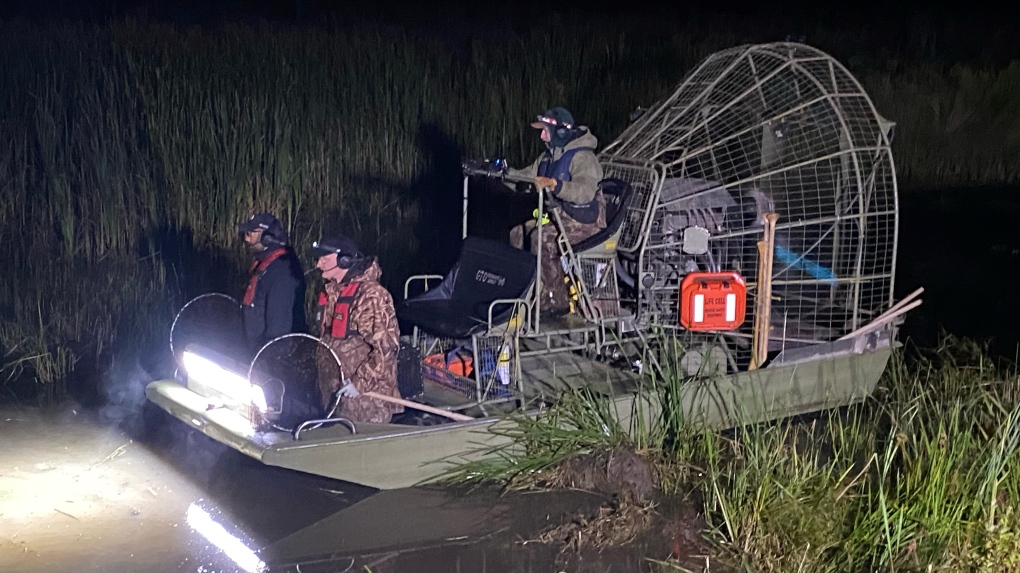Biologists busy banding ducks in New Brunswick’s wetlands
It’s a busy time of year for waterfowl biologist Ted Barney. As fall begins, he and his team at the Canadian Wildlife Service in Sackville, N.B., are tasked with banding more than 3,000 ducks across the Maritimes.
Barney and his team collect many of the ducks at nearby Tantramar Marsh, home to six to eight species of duck. Banding them helps biologists estimate populations, harvest rates and survival. The information will be used to set bag limits for the fall waterfowl hunting season.
The team heads out at dusk in an airboat powered by a corvette motor. After the sun sets, their nets and spotlights come out.
“The airboat allows us to get into multiple wetlands in an evening and be effective,” Barney said.
The airboat allows the team to access a lot of wetland. Barney said it reduces a month’s worth of work to a single night.
“The darkness of the night allows us to use the lights on the airboat to blind the birds,” Barney said. “They can’t see a horizon so they don’t fly and then we can use our dip nets to scoop them up, bring them back to shore and then we band them.”
 Three people aboard an airboat patrol the wetlands after dark.
Three people aboard an airboat patrol the wetlands after dark.
Once collected Barney and his team assess the sex, age and species of the duck and check it for diseases.
“Highly pathogenic avian influenza has been on the landscape in North America for roughly the last three years,” Barney said. “We have a monitoring program to look at background rates of the virus.”
The technique allows Barney and his team to monitor waterfowl health and put the information into a national database.
After the tests, the ducks are banded and set free in their habitat unharmed. Barney says it’s the way it’s been done for centuries and the animals are handled with care.
“The information coming from this is really critically important to what they do at the Canadian Wildlife Service in terms of managing these populations.”
Barney said the animal care standards for their protocols are assessed by a committee that includes veterinarians.
Barney said anybody can participate in the banding process. He encourages people who find a banded ducks to go online to find out the animal’s details.
For more New Brunswick news, visit our dedicated provincial page.
CTVNews.ca Top Stories

Poilievre writes to GG calling for House recall, confidence vote after Singh declares he's ready to bring Liberals down
Conservative Leader Pierre Poilievre has written to Gov. Gen. Mary Simon, imploring her to 'use your authority to inform the prime minister that he must' recall the House of Commons so a non-confidence vote can be held. This move comes in light of NDP Leader Jagmeet Singh publishing a letter stating his caucus 'will vote to bring this government down' sometime in 2025.
School custodian stages surprise for Kitchener, Ont. students ahead of holiday break
He’s no Elf on the Shelf, but maybe closer to Ward of the Board.
Kelly Clarkson's subtle yet satisfying message to anyone single this Christmas
The singer and daytime-talk show host released a fireside video to accompany her 2021 holiday album, “When Christmas Comes Around” that she dubbed, “When Christmas Comes Around…Again.
Judge sentences Quebecer convicted of triple murder who shows 'no remorse'
A Quebecer convicted in a triple murder on Montreal's South Shore has been sentenced to life in prison without chance of parole for 20 years in the second-degree death of Synthia Bussieres.
At least 2 dead, 60 hurt after car drives into German Christmas market in suspected attack
A car plowed into a busy outdoor Christmas market in the eastern German city of Magdeburg on Friday, killing at least two people and injuring at least 60 others in what authorities suspect was an attack.
16-year-old German exchange student dies after North Vancouver crash
A 16-year-old high school student from Germany who was hit by a Jeep in North Vancouver, B.C., last weekend has died in hospital, authorities confirmed.
Poilievre to Trump: 'Canada will never be the 51st state'
Conservative leader Pierre Poilievre is responding to U.S. president-elect Donald Trump’s ongoing suggestions that Canada become the 51st state, saying it will 'never happen.'
Canadiens executive says he has 'no concern' about members of the front office travelling to Russia
Montreal executive vice president of hockey operations Jeff Gorton said he has 'no concern' about members of the Canadiens' front office travelling to Russia with the country’s war in Ukraine ongoing.
Speeding drivers get holiday surprise from 'Officer Grinch'
Drivers in the Florida Keys who exceed the speed limit in school zones may run into a well-known gloomy green creature and get a surprising 'gift.'


































